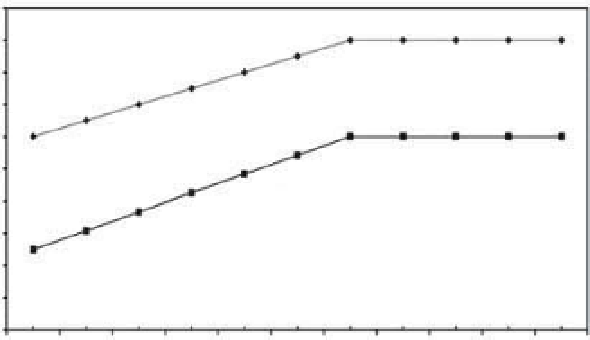Geoscience Reference
In-Depth Information
20
18
16
14
12
10
8
6
4
2
0
Organic soil material
Peat (fibric)
Mucky peat (hemic)
Muck (sapric)
Mucky modified mineral
soil material
Mineral soil material
0 0 0 0 0 0 0 0 0 0 0
% clay
Figure 5-10.
Classii cation of organic and mineral hydric soils according to contents of clay and organic carbon.
Adapted from Vasilas, Hurt and Noble (2010, Fig. 53).
soils that contain sulfur-bearing compounds, so
it is not found in all hydric soils. In aerobic soils,
most carbon compounds are oxidized by soil
microbes. However, this process slows consider-
ably under anaerobic conditions, particularly in
colder climates, and partly decomposed organic
matter may accumulate as peat, muck, or
organic-rich mineral layers. In the i eld, organic
content may be estimated by rubbing a sample
between the i ngers and examining with a hand
lens (Vasilas, Hurt and Noble 2010). The organic
material is further classii ed as sapric, hemic, or
i bric based on the i bers visible with a hand
lens. These terms correspond respectively with
muck, mucky peat, and peat (Fig. 5-10).
Color is among the best indicators for the
status of iron and organic matter in hydric soils,
as noted in section 3.4.1. Soil color is observed
under moist conditions. Wet soils should be
allowed to dry out until they do not glisten,
and dry soils should be moistened until color
becomes stable (Vasilas, Hurt and Noble 2010).
It is important to examine color in the i eld soon
after collecting samples, as ferrous iron may
oxidize rapidly when exposed to air (Fig. 5-11).
more of the essential nutrients than do mineral
soils, but in practice the nutrients are bound in
organic compounds and are not readily avail-
able for plant growth. Thus peat and muck soils
tend to be oligotrophic, meaning that they are
dei cient in nutrients. Furthermore, organic-rich
soils tend to be acidic. The combination of
scarce nutrients and low pH limits the types of
plants that can live in such soils.
Sphagnum
moss, for example, thrives under oligotrophic
and acidic soil conditions (Fig. 5-12), but rela-
tively few other plants can survive. This situa-
tion explains why conversion of organic-rich
hydric soils into cropland often fails (see Fig.
14-7). Nutrients are insufi cient to support crop
plants, so fertilizer must be added in large quan-
tities to sustain crop production.
Mineral hydric soils generally have more
nutrients available for plant growth and less
acidic conditions compared with organic-rich
soils. Inl ow of surface or ground water may
also deliver nutrients leading to mesotrophic or
eutrophic conditions. The result is greater l oris-
tic diversity and higher primary productivity
(Fig. 5-13). Of course, many variations or excep-
tions exist in terms of hydric soil conditions. In
semi-arid or arid environments, for example,
high soil salinity may be a limiting factor for
plant growth. Where limestone or dolostone is
present, acids may be neutralized, so that soil
and water pH become intermediate to basic.
5.4 Mineral and organic hydric soils
Soils provide the nutrients that plants need for
growth. In principle, organic-rich soils have






